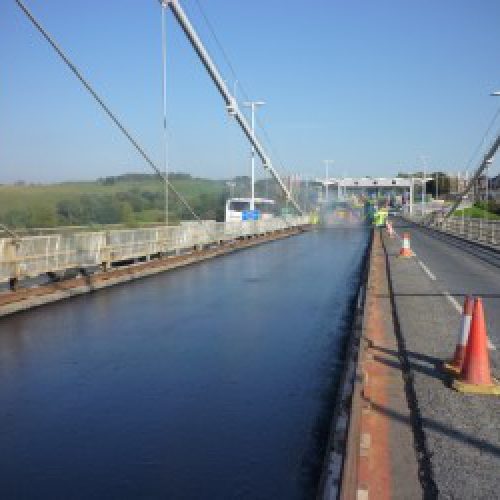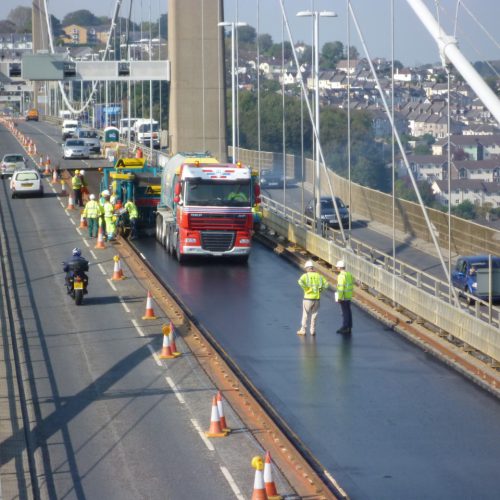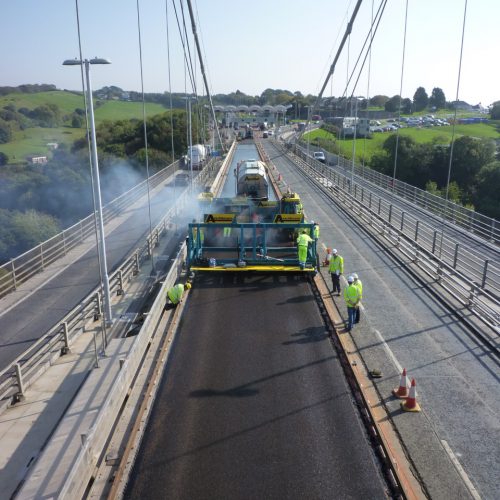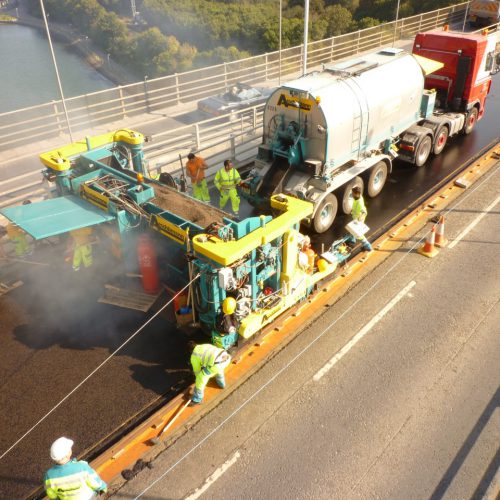Our contractors VolkerLaser have made significant progress following the start of work on the second phase of the resurfacing scheme on Monday. Planing works to remove the existing surfacing on the north half of the main deck were completed on Tuesday - two days ahead of schedule.
Work is now taking place to prepare the steel deck to accept the first waterproofing membranes. This includes using the wheeled excavator (‘rubber duck’) machine to scrape the deck and mechanical and hand tools to remove remaining material at the kerb interfaces. This will be followed by the specialist blasting contractor removing the last 8-10mm of deck material with an enclosed shot blasting system.
Unfortunately the contractor was unable to complete any works on the bridge on Friday morning due to the high winds, with recorded wind speeds of more than 50mph making working conditions unsafe. Staffing levels were unfortunately also affected by COVID. However work on scraping the deck has recommenced today.
Work on the north half of the deck is currently due to be completed by the end of August. While these preparatory works can take place during poor weather, laying the waterproofing system and the specialist asphalt surface has to be carried out in dry weather.
Work on the south half of the deck will follow immediately afterwards and is due to be completed on schedule by the end of October.
We recognise the challenges faced by people crossing the bridge and living and working in nearby communities at the beginning of the week, with long delays at times on Monday and Tuesday. There was also very heavy westbound traffic on Friday which led to congestion and delays.
We are extremely sorry for any inconvenience this caused to travellers.
We have been working closely with our contractors to refine the process for changing the priority on the tidal flow lane on the main deck to manage traffic flow more effectively and respond quickly to incidents and breakdowns.
Thanks to the hard work of our control room staff and project teams the lane priority can now be reversed in less than 20 minutes and, under optimum conditions, in less than 12 minutes. This compares with eight minutes using the overhead electronic system.
Our on-site vehicle recovery team have recovered two broken down vehicles from the cantilevers since Monday, taking between just 11 and 30 minutes to recover the vehicle and safely return it and its occupants to Saltash services.
During the last few days we have seen more westbound drivers using the south cantilever (normally associated as a footpath / cycleway) rather than queuing to use the lane on the main deck when we are running two lanes west bound. This is helping to reduce traffic build up coming from the Plymouth direction more quickly which, in turn, then allows us to change the lane priority and open two lanes eastbound.
While this is positive news, we are aware that some people are still experiencing longer than usual delays and are continuing to look at how we can further improve our traffic management procedures.
We are also aware that some drivers travelling eastbound on the A38 are diverting through Saltash at the western portal of the tunnel to try to beat the queues. As drivers adapt, lane capacity should increase, allowing greater flexibility to reverse priority to balance demand. This should also ease Saltash local traffic when we run two lanes east bound as local users will have access to a dedicated lane across the bridge.
Lane 7 on the toll plaza is now fully operational as a tag only lane with other booths opened as required to match approaching traffic. The plaza is being supported by 24hr on-call locally based maintenance teams.
A number of people have asked why we cannot work on one lane on the main deck at a time.
The simple answer is that it would not be safe or practical to do so.
The main bridge deck works are being completed in two phases. Firstly, work is taking place on the north half (the eastbound lane and half of the centre lane), followed by work on the south half (the westbound lane and the remaining half of the centre lane), with a surfacing construction joint running along the centre line of the bridge. This is the same technique that we used successfully when the Plymouth side span was fully resurfaced in September 2011.
To make the site safe for both bridge users and the workforce, plant and equipment, we need to provide sufficient segregation of the work area from the traffic using the bridge. This means closing two full traffic lanes in order to meet the national standards for traffic management schemes and safety zones which further reduces the width available for the works.
Additionally, the three traffic lanes on the main deck are narrower than normal carriageway widths at only 3.33m per lane. Working on one main deck lane at a time is not possible because of this narrow width, and when working in the centre lane, it would require us to run traffic both sides of the work site and this is not safe or practical.
Even if we could practically work on one lane at a time, because of the narrow lane widths it would mean reducing the speed limit to 20mph, as well as running a traffic light and convoy system which would cause even further delays.
Each layer of the north half of the bridge surfacing system (paint primer, 2 layers of waterproofing and 2 layers of new surfacing material) must be laid so that there is an overlap available at the centre of the bridge ready to accept the south half of the new system during the next phase. This overlap detail requires approximately 200-300mm or so beyond the edge of the asphalt layer and this also affects the size of the working areas required. This important construction detail will ensure the integrity and durability of the new surfacing for the next 20-25 years.
Today’s photos from the resurfacing of the Plymouth side span in 2011 illustrate just how constrained the works site is, as well as showing the overlap detail at the centre of the bridge.




